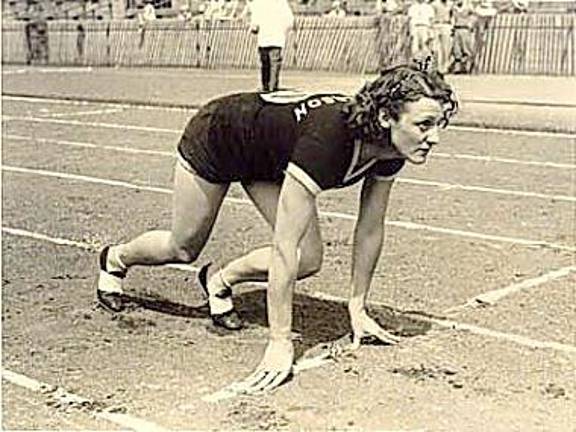Eleanor Egg Krattiger, the famous track and field star who lived in West Milford
WEST MILFORD. He achievements were enshrined in a plaque in the original Hinchcliffe Stadium, but future recognition is unknown.

Earning the title of “World’s Fastest Woman” when she defeated the Women’s National AAU Champion in a 100-yard dash in 1931, Eleanor Egg, originally a Paterson resident, eventually moved to the Macopin section of the Township of West Milford. She opened dance schools and taught many long-time residents – who are now grandparents – to dance.
Egg was married to Charles Krattiger. They built a home on property at the north corner of Macopin and Maple roads and their daughter Carolyn Krattiger (now a Florida resident) and Egg’s mother, an artist, lived with them. Egg opened dance studios in township church and fire house-rented facilities. Their home site bordered what is now a local environmental area; it was across Maple Road from the home where Frank M. Sell — a sailor who died during World War II when the Juneau was sunk in Pacific warfare — grew up, long before the Krattigers moved into the township.
Egg, at various times in the late 1920s and early 30s, held practically every woman’s national title on the books. For a long time, her dream was to participate in the Olympics. When she qualified to compete in the 1932 world competition, that dream came within reach.
Although she was approved to participate, a leg injury destroyed her plans. She had qualified for the Olympics competition by beating the great, previously unbeaten Stella Walsh in the national 100-yard dash championship for women. The triumph over Stella happened at the National Women’s Track and Field meet in Jersey City. This gave Egg a place on the 1932 Olympics Team.
Her joy would be short-lived because participating in the Olympics turned out to be a dream unfulfilled. Shortly before the team was to board an ocean liner to sail for France where the Olympics were to be held, Egg tore the ligaments in her left leg in a freak accident that happened when she was demonstrating the broad jump.
Disappointed, she was forced to resign from her Olympic team. That injury signaled the end of her athletic career. Not to be defeated, she initially used her energy and skills to coach young athletes and later opened her dance studios.
After her husband died, Egg and her daughter Carolyn moved to Cape Coral, Florida. Among Egg’s awards were some 227 medals, 22 silver cups, 15 statuettes and a trunk full of other memorabilia. The City of Paterson honored her by erecting a bronze plaque in the original Hinchcliffe Stadium. The plaque pictures Egg as a young athlete. Its inscription tribute it read, “Eleanor Egg – Champion of America.” The bronze bas-relief of Egg was by sculptor Gaetano Federice.
The Friends of Hinchcliffe Stadium is a 501c3 nonprofit founded in 2002, made up of volunteers who love and respect history and want to preserve and vitalize it. There is not a concrete date for completion and official opening of the new Hinchcliffe stadium, but a published report said the reconstruction needed to be done by the end of 2023 based on a tax credit stipulation.
All available internet information appears to center on recognizing the reconstructed stadium for its baseball history. There has been no mention found in the press about Eleanor Egg or the bronze plaque that was in the stadium, or if she or the plaque are included in the present reconstructed stadium plans.
Eleanor Egg Krattiger was born in 1909 during a stop for her parents’ traveling vaudeville act at Wilkes Barre, Pennsylvania. When she was just two years old she became part of the vaudeville act and was billed as “The Youngest Acrobat in the World.” She thrilled audiences by walking on her hands – when she was so young that she could barely walk on her feet. Eleanor died at age 90 in her Florida home in 1999.
